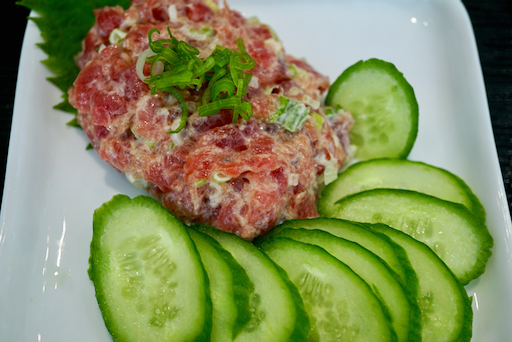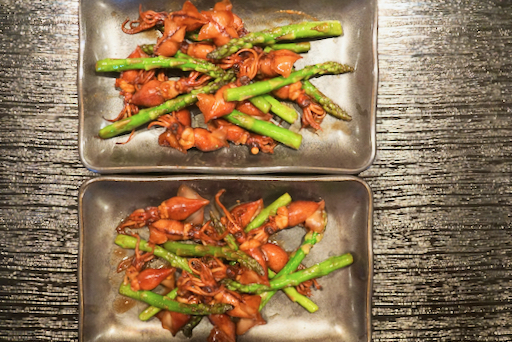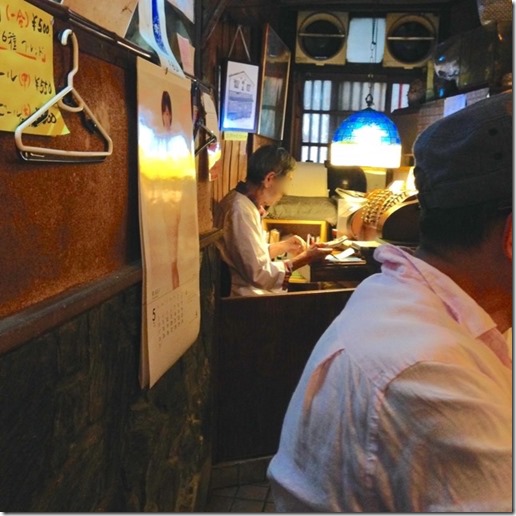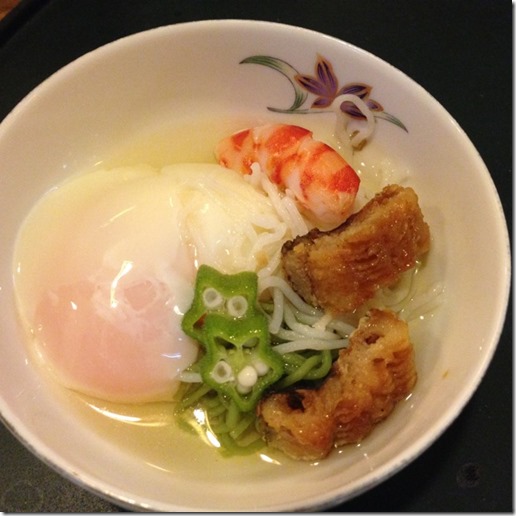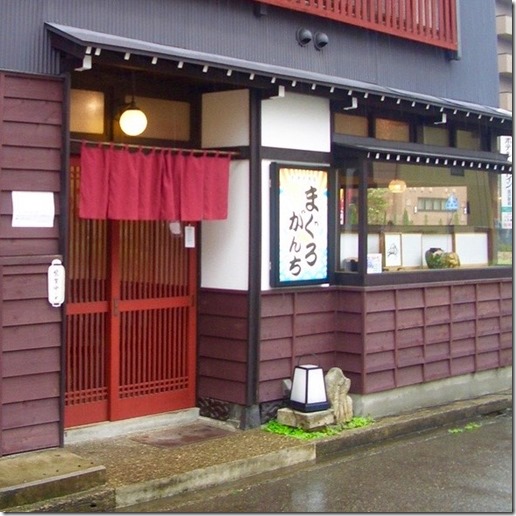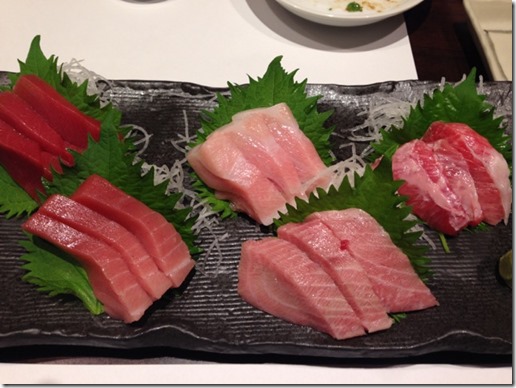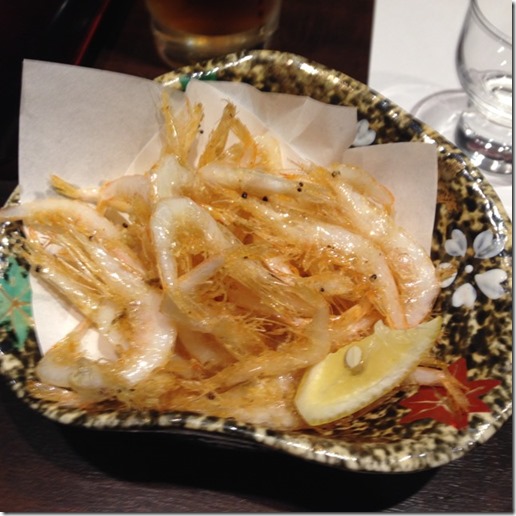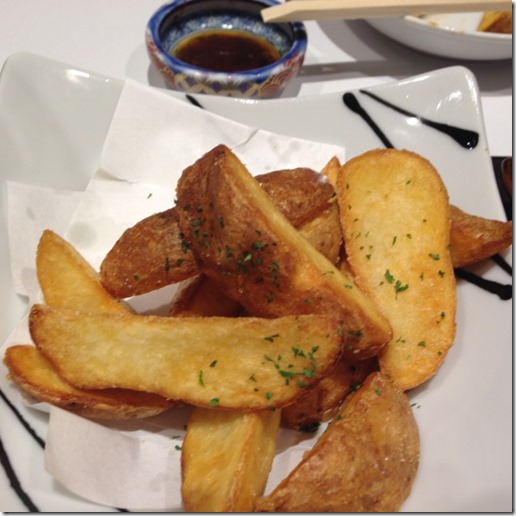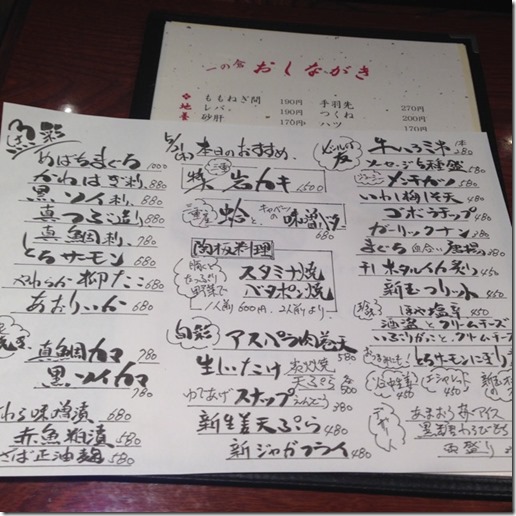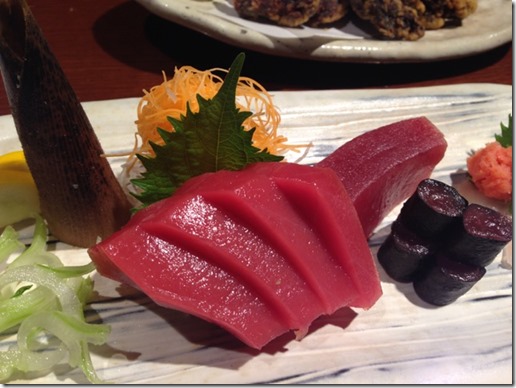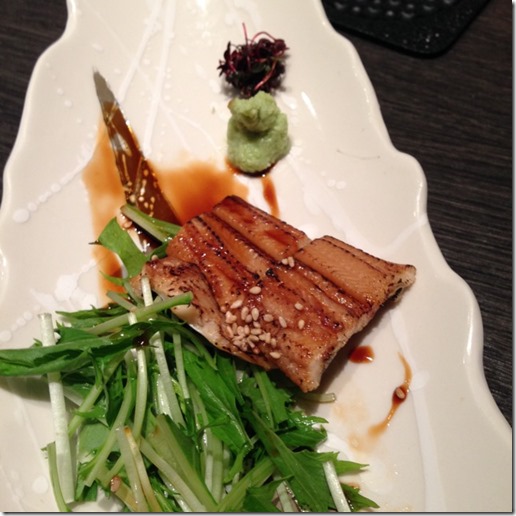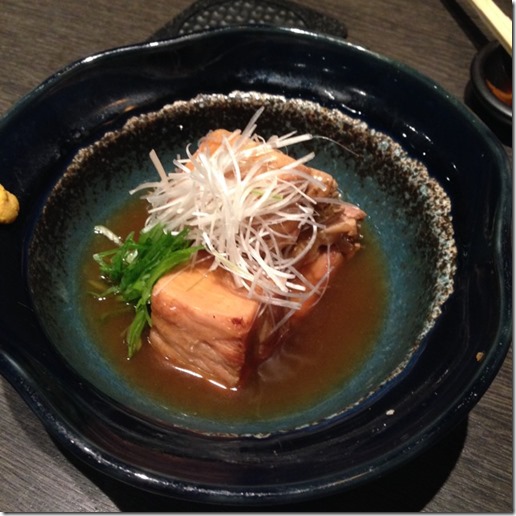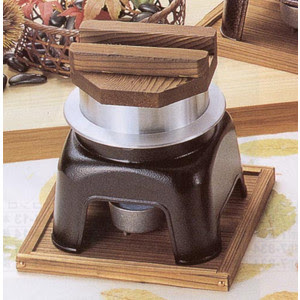We recently went to New York with the primary purpose of exploring Izakaya-style restaurants there since they are quite numerous. We did a 3 nights 4 day excursion. We chose the restaurants based on information I
gleaned from the Internet. I chose three different style restaurants representing 1. robatayaki/Izakaya style, 2. Sake bar, 3. Yakitori-ya. If we had more time, we could have ventured out to smaller restaurants but we didn’t do that this time because very small places don’t take reservations. (We’ll explore them next time). One of the first places I tried to get a reservation was "Sakagura 酒蔵"
which was featured in one of the
Anthony Bourdain's episodes on the television show "No Reservations". According to the Sakagura website, they strongly recommended "reservations". (So did "No Reservations" have a "reservation"?) I called several times but no answer and the messages I left were never returned so we had “no reservation” and didn't go there.
This is by no means a restaurant review but more a record for ourselves of the great time we had. Although I took a camera, I did not take any pictures. Somehow, as the meal unfolds and I immerse myself in the enjoyment of the food and drink the idea of taking a picture of the experience becomes distracting and falls by the wayside (even though that doesn’t seem to be the case with the other people snapping pics to the right and left of us). I am sure most of those pictures are destined for Facebook and Instagram to "share" the experience with friends). So all the pictures shown here are either from Google street views (all the outside pics) and from the corresponding websites of the restaurants.
1. Aburiya kinosuke 炙り屋錦乃助
The picture below shows the outside of Aburiya. It is the left entrance of the building with the vertical stripes of green, blue, yellow and red. Despite the bright colors visible in this picture there is not much signage indicating the location of the restaurant except a demure blue "Noren" at the entrance. It was a 20 minute walk from our hotel to the restaurant. I was navigating using Google maps on my iPhone and I knew exactly where we were and where the restaurant was supposed to be located. But we couldn’t find it. We walked back and forth on the block several times but we could not see anything that looked like an Izakaya or Japanese restaurant. We saw the
Wyndham Hotel (below left). Was the restaurant located in the hotel? I ended up calling the restaurant. The manager first tried to explain that the entrance was to the right of the Wyndam. There was in fact a restaurant on the right side of the Wyndham but it was definitely not an izakaya. Finally the manager said "just wait there". He came out to the sidewalk found us literally standing in front of the restaurant and ushered us in. How embarrassing.

Inside is surprisingly large (deep). The front of the restaurant had tables and, in the back, (going down few steps) there was a L-shaped counter which can seat about 10 or more people. Inside the counter, there was a grill and 3 young chefs in Aburiya T-shirts busy at work. On the left side along the wall were a few shelves on which 10 or so individual "
Kamameshi" 釜飯 vessels were placed. (see below, this pic is from
http://store.shopping.yahoo.co.jp/kappabashi/m10-230.html).
We noticed that occasionally flames appeared under some of the "kama" vessels. This must be how they cook the individual "Kamameshi". We were advised that if we wanted Kamameshi it would take about 40 minutes so get the order in early. We were seated at the counter in front of the "sashimi" station or #1 and 2. (I specifically asked for counter seating). The chef was busy cleaning and removing the fillets from whole fish which was a good sign. I tried to engage him in conversation but he was too busy. Another chef was in charge of grilling and yet another serving up other dishes.
We started with two cold sake "Uragasumi" 浦霞 (junmai) and "Kokuryu" 黒龍 (Ginjou). They brought us a wooden box with ice in the bottom and two empty sake carafes (Probably Bizenware 備前焼 or imitation thereof—very nice). Then, they brought up the sake bottles, showed us the labels and then poured into the carafes. A very nice touch assuring us we were actually getting the sake we ordered.
We started with the sashimi three kinds (which were salmon, kampachi and flounder). The sashimi was good (although the salmon was the best sashimi which tells me that tuna and other good sashimi fish must be difficult to get or too expensive). One thing that struck us as different was the use of an artificial-appearing transparent thready thing made of agar-like material* (hope this is not plastic since I ate some of it) instead of the usual daikon "tsuma" 大根のつま garnish. We’d rather not to have any garnish than this stuff.
P.S. Later I
came across this item on the Web. It is called "Kaisou-men" 海藻麺 or "Kaisou vidro" 海藻ビードロ (
Vidro means "glass" in Portuguese) and made from sea weed.

Although the details of what we ate escapes me a bit, we had "smoked daikon pickles or "Iburi gakko" いぶりがっこ, homemade tofu with three different flavored salts (above picture on the right), firefly squid "okizuke" ホタルイカの沖漬け (excellent!), Tuna "nakaochi" yukke (鮪の中落ちユッケ, tuna tartar Korean style) with a porched egg or "onsen" tamago 温泉卵. This was in good quantity and tasted good. We had few more items such as pork belly "kakuni" 角煮 (we could not pass up this item, good size and melt-in-your-mouth excellent with honey-flavor). We had more sake (Dassai 獺祭50) and some more food. We were too full for any rice dish to end the evening.
This is not an authentic robatakayaki or Izakaya but it is a very nice drinking place to visit and reminds me of some high-end chain Izakayas in Japan. The counter area, at times, got sort of smoky adding to the atmosphere. There was plenty of hustle and bustle that again added nicely to the atmosphere. It was a great place to “people watch”.
Information on Aburiya Kinosuke
213 E 45th St, New York, NY 10017
212-867-5454
Aburyakinosuke.com
2. Saka mai 酒舞
Since I could not get a reservation at Sakagura, I chose this place. The name "SakaMai" usually means rice specifically grown for making sake or 酒米 but they attached the ideograms 酒舞 meaning "sake" and "dance". It is on the lower east side in an area that apparently used to be a residential with old town houses lining the side streets. The restaurant was a renovated old town house (there was apparently another restaurant at this location previously as you can see in the Google street view below). The best way to direct a taxi cab to the restaurant is to say "Please take us to
Katz's delicatessen at E Houston and Ludlow. The cab dropped us off in front of the delicatessen and we worked our way through the crowd of tourists standing out front taking pictures. It was a short one and half block walk from Katz's to SakaMai. The restaurant has been in business for about 6 months according to the Japanese bartender (or mixologist as he preferred to be called) who spoke with a Japanese-British accents (spent 7 years in London) . By the way, the lot next to the SakaMai was still empty as shown in the picture below.

Once inside the restaurant, it is a totally different world from what you may have expected from the streets and exterior. Again it is a large place since it is very deep. The front part had tables and the back had a bar counter as you see below. Nice warm light wood decor. We sat at the counter.

Although we did not come for the cocktails, we decided to take advantage of the expertise of the resident mixologist. The sake based drinks were unique and delicious. My wife had "Haizakura" 灰桜 and I "Sakoudo" 酒人. "Haizakura" is composed of sake, plum wine, salted plum (umeboshi) vinegar and peach liquor. It was interesting and quite good but a bit too sweet for us. "Sakoudo" is a type of "saketini" made with sake, Hendrick's gin, mirin, orange bitters. It has a faint but unmistakable citrus note. I initially thought it had a "yuzu" flavor. I am not sure it is from the Hendrick's gin or orange bitters but must be the latter.
We then had flights (three small glasses each) of "genshu" 原酒 and "daiginjou" 大吟醸. I do not quite remember all the sake we tasted (taking pictures may have helped). One of the "Genshu" was "Kikusui"
菊水一番しぼり which was poured from an aluminum cup (one of the "cup sake") (see picture below). I do not remember the name of other two now.
The daiginjou flight included "Dassai 50" 獺祭, and Hakkaisan 八海山. We like the third diaginjou which I do not recall the name (despite my wife's telling me to remember the name). We had a cup each of daiginjou and genshu. These sake were not bad but none was extraordinary. We wished more information about the sake we tasted was provided to us especially since this is a sake bar.
For food, we started with "Kampachi" crudo. It is a small serving but nicely done. Good quality kampachi sashimi garnished with finely chopped perilla, myouga and wasabi with shoyu graze. Uni crostini was again small and grilling made the delicate flavor of uni to diminish a little. We also had egg-on-egg-on-egg (picture below). This is a very nice creative dish. Instead of a real sea urchin shell seen in the picture below, it was served in a porcelain bowl made to look like a sea urchin shell. The bottom was nice creamy scrambled egg topped with caviar and uni. You cannot go wrong with this combination but it was excellently prepared.The "chawan mushi" 茶碗蒸し was forgettable. The croquette was ordinary and we could not find any lobster meat albeit it was called lobster croquette. We also had grilled dried skate wings and renkon chips. Interestingly, the renkon chips were the only sizable appetizer we had all evening but they were crisp and addictive.

For the ending dish, we each had a pork bun which was very elegantly done. The pork filling was great--a large tender chunk of pork belly. They have a larger dish of steak and mushroom rice to be shared with 2 or three but we were stuffed so it was out of the question for us.
Information on SakaMai
157 Ludlow Street
New York, NY 10002
(646) 590-0684
sakamai.com
3. Torishin 鳥心
The last day, we went for Yakitori. We took a taxi cab. Having learned that traffic is generally bad at any time we took precautions and started early to get to our reservation on time. But, of course, this was one of those rare instances in New York when our taxi sped through the streets without slowing down (even for the stop lights) and we arrive there 30 minutes earlier that the designated time.
The outside was rather un-assuming. Since I did not take any pictures, this is from the Google maps street view (below). Once inside, the interior was quite nice with lots of light colored wood (second pics below which is from their website).

The restaurant was mostly counter seating with a few small tables. Even though it was fairly early the place was basically packed when we arrived (good thing we had a reservation). We sat at the corner of the counter next to the chef tending the grill. The menu is very close to Japanese counter parts especially those of more modern/tame chain yakitori places which have proliferated in Japan (I do not indicate a negative here, it is clean and nice).
They had a special cold sake they recommended. This is supposedly a seasonal special, un-pasteurized or "nama genshu" 生原酒 sake , I think, it was Ichino-kura namagenshu 一の蔵生原酒. There may have been "arabashiri*" 荒走り on the bottle label as well. This was quite good with nice crisp taste and clean fruity notes. Towards the end, we run out of sake and ordered a glass of "Nanbubijin daiginjou" 南部美人. They served us in a glass with a generous spillover into the "masu" ます saucer. Actually, this was the best sake for the evening.
*Arabashiri (meaning "wild runs") is the first portion of sake comes out without any pressure when it was filtered/pressed in the traditional way (not using a modern mechanized press). Supposedly it shows more wild and flavorful sake.

In front of the counter was a cold display case similar to the kinds seen in any sushi bar. Many prepared skewers were displayed inside. There were two grills (or "Yakidai" 焼き台) one near the right corner where we were seated and the other at the opposite corner.They are boasting the use of Japanese lump charcoal called "binchoutan 備長炭 which is known to burn hot. Despite the ventilation system just above the grill some smoke escaped every-now-and-then and added to the ambience but never became too smoky as can sometimes happen in small Yakitori places in Japan.
The vegetable skewers were displayed on the top of the cold case in the bamboo basket (see below, again the pic is from the Torishin website). Interestingly there was small sign in the middle of the basket saying "Display only (in English)". We thought these were fake skewers for display only (like realistic models of dishes seen in many restaurants in Japan) and admired how they looked so real. Then, we noticed the woman chef was taking theses skewers from the basket and giving them to the griller. Apparently these are real vegetable skewers. We have no idea, in that case, the meaning of the sign "Display only".

The yakitori menu is rather standard but rare parts are reserved for the "omakase " course and cannot be ordered as a-la-carte which included two kinds (from kiel and back bone) of "cartilage" 軟骨, neck meat せせり, kidney 背肝 etc. We just went with a-la-carte. the chicken liver 肝 was underdone (I am sure this was what the grill chef intended) which made us a bit uncomfortable since we had to assume they were from US chickens with the possibility of salmonella. (They said they were using "organic" chickens, whatever that means). Skin 雛皮, tail ぽんじり (ponpochi or ponjiri), heart ハツ, and tsukune つくね were good. Fatty pork belly "tontoto" 豚トロ was also good. Chicken thighs 腿 with different sauces, grilled quail eggs ウズラの卵 and ginko nuts 銀杏 were just OK. Chicken wings 手羽 were small but with a nice crispy skin and were great. As a special vegetable, they had a small radish or "ko-kabu" 小蕪 (which was simmered in dashi broth first, then grilled, and served in a small bowl with sweet miso and vinegar sauce. We were not sure if the grilling added anything. The sauce was excellent and my wife detected honey in the sauce. For vegetables (we need the nutritional balance), we ordered assorted "tsukemono" 漬物 which was a bit disappointing especially the cucumber was over pickled and too thinly sliced. I do not remember how many more skewers we ordered but the size of the skewers were quite small compared to those in many Yakitori places in Japan. As a result, we ended up eating quite a few skewers. They also have rice dishes (Donburi 丼 or rice bowl affair) but we were quite full and well-watered at this point. Instead, we went back to our hotel and enjoyed a nice glass of cava at the bar and interesting conversation with the bartender.
Information on Torishin
1193 1st Avenue
New York, NY 10065













